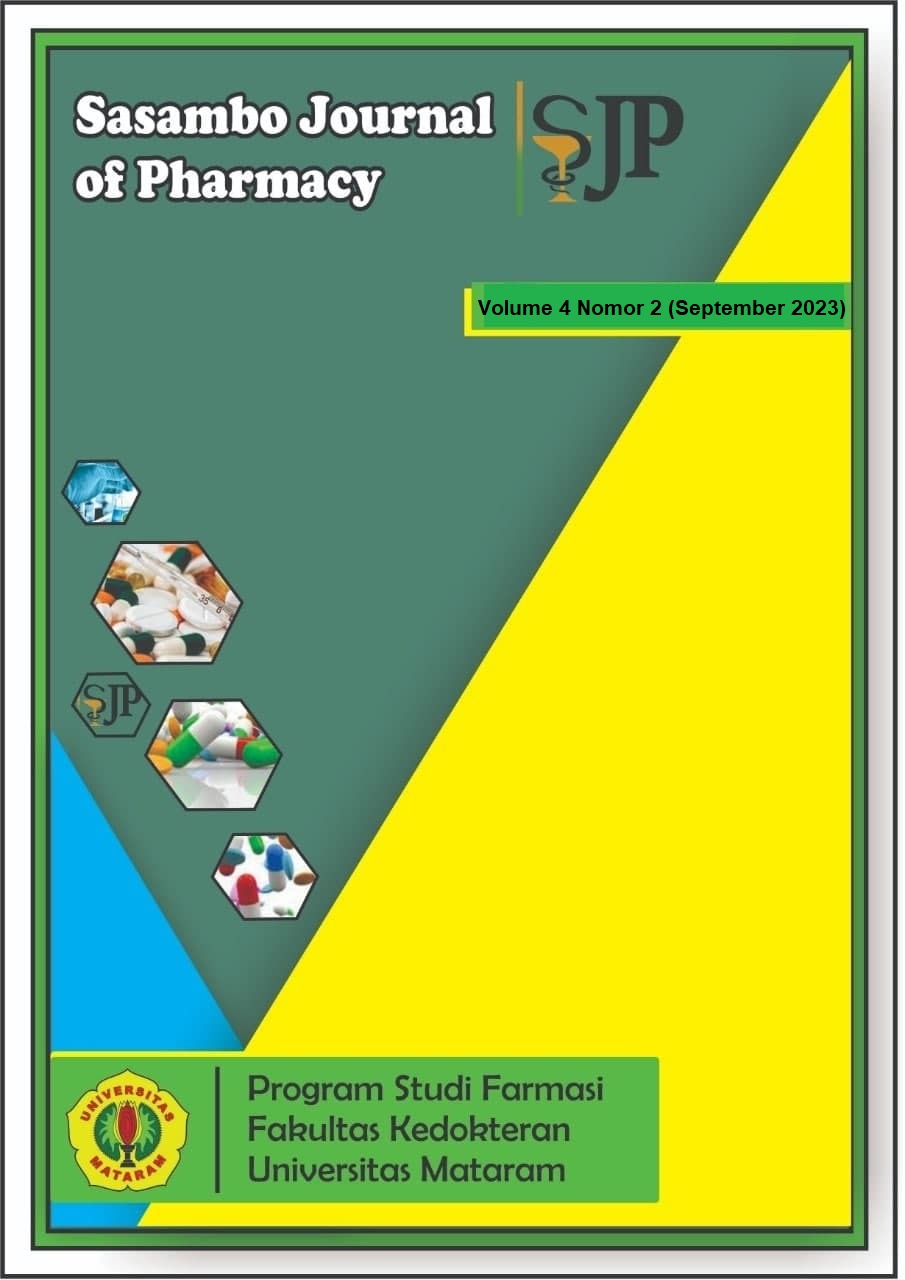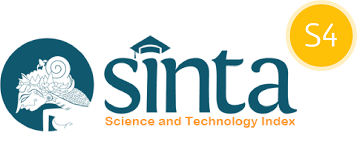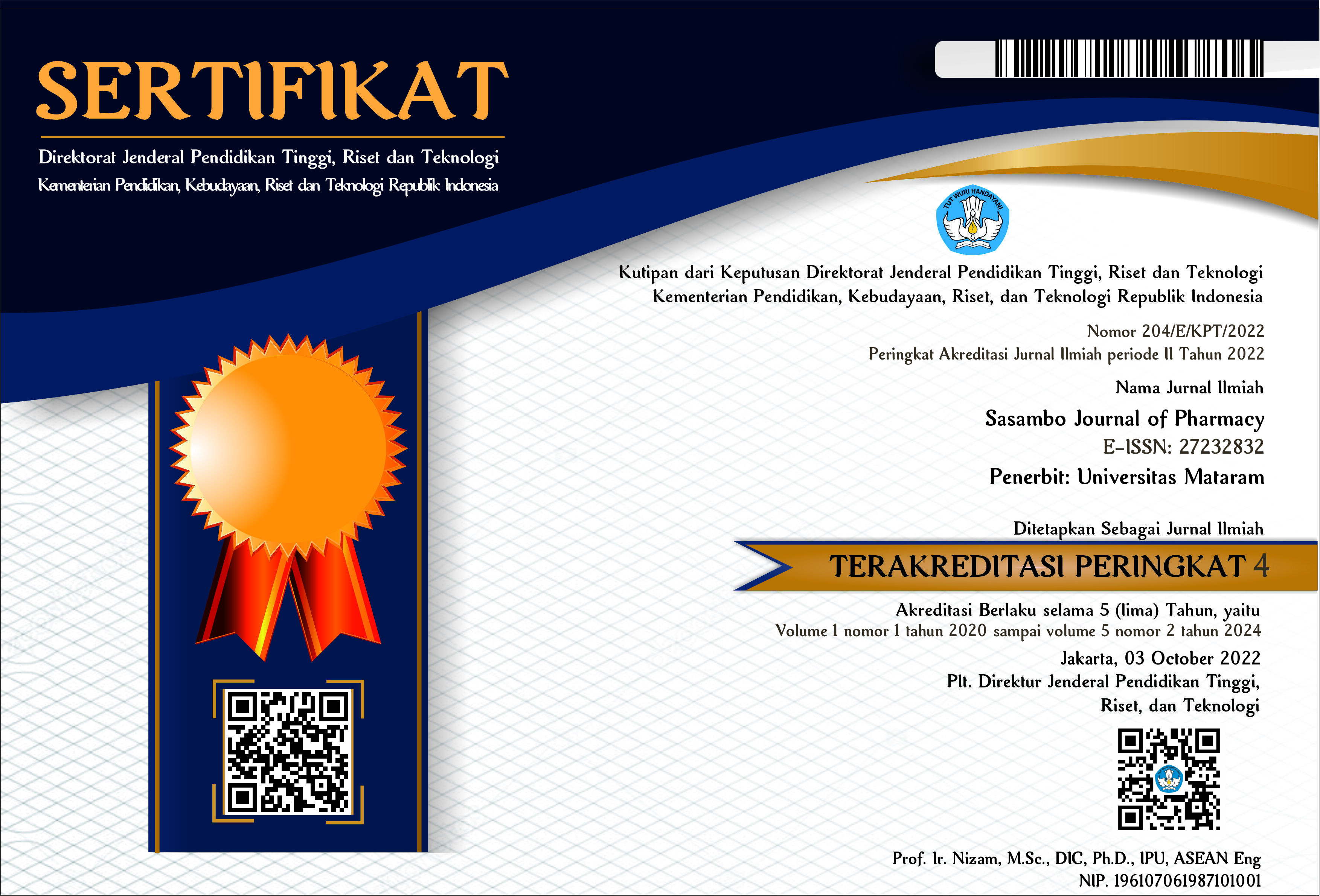Abstract
Food contaminant aflatoxin is a mycotoxin produced by Aspergillus flavus and A. parasiticus. This article aims to discover the pathophysiological, immunological, pharmacological, toxicity, and reduction and detection methods of aflatoxin. Kinds of literature were obtained from Research Gate, Pubmed, and Science Direct with the primary keyword “aflatoxinâ€. Pathophysiologically, aflatoxin-contaminated food has been proven to cause necrosis in liver cells, developing into liver cancer. Immunologically, aflatoxin decreases monocyte and dendritic cell phagocytosis, neutrophil cell ATP production, and pro-inflammatory cytokine synthesis. Aflatoxin toxicity is at the LD50 of 12-16 mg/kg b.w, causing death. Pharmacologically, 120-201 µg/kg b.w causes aflatoxicosis, in vivo studies indicated that NovaSil, Sulfarophan, and Monanthotaxis caffra leaf extract may reduce its toxicity. Aflatoxins are highly thermostable; hence, once food has been contaminated, they cannot be destroyed by normal cooking process. The control and reduction should be conducted in post-harvest handling, common physical means practiced are heating, drying, and smoking. Chemically using ozone, 0.5 sodium bisulfate, 1% sodium hydroxide, 5% acetic acid, and prochloraz. Biologically using Flavobacterium aurantiacum B-184, Bacillus velezensis DY3108, and, a consortium of Geobacillus and Tepidimicrobium bacteria. Aflatoxin can be detected using TLC, HPLC, MS, ELISA, and UHPLC-ESI MS/MS. The prevention of aflatoxin occurrence is done through good post-harvest handling, good manufacturing practices, and applying regulations accordingly to ensure food products and feed are at acceptable levels of aflatoxin.
Keywords:
Aflatoxin, Aspergillus, food, mycotoxin, liver cancerReferences
Aliabadi, M. A., Alikhani, F. E., Mohammadi, M., & Darsanaki, R. K. (2013). Biological control of aflatoxins. European Journal of Experimental Biology, 3(2), 162–166. https://www.primescholars.com/articles/biological-control-of-aflatoxins.pdf
Andrale, D. P., Caldas, D. E., and Gomes de Silva, L. J. (2013). Simultaneous analysis of aflatoxins B1, B2, G1, G2, M1 and ochratoxin A in breast milk by high-performance liquid chromatography/fluorescence after liquid–liquid extraction with low temperature purification (LLE–LTP). Journal of Chromatography A, 1304, 61–68. https://doi.org/10.1016/j.chroma.2013.06.049
Benkerroum, N. (2020). Aflatoxins: producing−molds, structure, health issues and incidence in southeast Asian and Sub−saharan African countries. Int. J. Environ. Res. Public Health,17, 1215. https://doi.org/10.3390/ijerph17041215
Bernáldez, V., Cordoba, J.J., Magan, N., Peromingo, B., & RodrÃguez, A. (2017). The influence of ecophysiological factors on growth, aflR gene expression and aflatoxin B1 production by a type strain of Aspergillus flavus. LWT - Food Science and Technology, 83, 283–291. https://doi.org/10.1016/j.lwt.2017.05.030
Brown, R., Priest, E., Naglik, J. R., and Richardson, J. P. (2021). Fungal Toxins and Host Immune Responses. Front. Microbiol. 12, 643639. https://doi.org/10.3389/fmicb.2021.643639
Brožková, I., Šmahová, P., Vytřasová, J., Moťková, P., Pejchalová, M., & Šilha, D. (2015). Influence of chosen microbes and some chemical substances on the production of aflatoxins. Potravinarstvo Slovak Journal of Food Sciences, 9(1), 9–17. https://doi.org/10.5219/416
Chu, X., Wang, W., Yoon, S.C., Ni, X.Z., & Heitschmidt, G.W. (2017). Detection of aflatoxin B1 (AFB1) in individual maize kernels using short wave infrared (SWIR) hyperspectral imaging. Biosystems Engineering. 157, 13-23. https://doi.org/10.1016/j.biosystemseng.2017.02.005
Darsanaki, R., & Miri, M. (2013). Aflatoxin M1 contamination in dairy products. Journal of Science and today's World, 2, 500–514. https://www.researchgate.net/publication/236963843_Aflatoxin_M1_Contamination_in_Dairy_Products
Dhakal, A., Hashmi, M. F., & Sbar, E. (2023, Februari 15). Aflatoxin Toxicity. In: StatPearls [Internet]. Treasure Island (FL): StatPearls Publishing. https://www.ncbi.nlm.nih.gov/books/NBK557781/
Gizachew, D., Chang, C.H., Szonyi, B., De La Torre, S., & Ting, W.E. (2019). Aflatoxin B1 (AFB1) production by Aspergillus flavus and Aspergillus parasiticus on ground Nyjer seeds: The effect of water activity and temperature. Int J Food Microbiol, 2(296), 8-13. https://doi.org/10.1016/j.ijfoodmicro.2019.02.017
Guan, Y., Chen, J., Nepovimova, E., Long, M., Wu, W., & Kuca, K. (2021). Aflatoxin Detoxification Using Microorganisms and Enzymes. Toxins, 13(1), 46. 10.3390/toxins13010046
Hooshfar, S., Khosrokhavar, R., Yazdanpanah, H., Eslamizad, S., Kobarfard, F., Nazari, F., Kokaraki, V., Kokkinakis, M., Goumenou, M., Tsitsimpikou, C., & Tsatsakis, A. (2020). Health risk assessment of aflatoxin M1 in infant formula milk in IR Iran. Food and Chemical Toxicology, 142, 111455. https://doi.org/10.1016/j.fct.2020.111455
Huang, L.C., Zheng, N., & Zheng, B.Q. (2014). Simultaneous determination of aflatoxin M1, ochratoxin A, zearalenone and alpha-zearalenol in milk by UHPLC-MS/MS. Food Chemistry, 146, 242-249. https://doi.org/10.1016/j.foodchem.2013.09.047
Jalili, M. (2016). A review of aflatoxins reduction in food. Iranian Journal of Health, Safety, and Environment, 3(1), 445–459. A review on aflatoxins reduction in food. | Semantic Scholar
Kibwana, M., Kimbokota, F., Christopher, R., & Mmongoyo, J. A. (2023). Aflatoxins in stored maize, maize flours, and stiff porridge consumed in schools: A case study of Dodoma region, Tanzania. Food Control, 146, 109519. https://doi.org/10.1016/j.foodcont.2022.109519
Kumar, A., Pathak, H., Bhadauria, S., & Sudan, J. (2021). Aflatoxin contamination in food crops: causes, detection, and management: a review. Food Prod Process and Nutr. 3, 17. https://doi.org/10.1186/s43014-021-00064-y
Magnussen, A., & Parsi, M. A. (2013). Aflatoxins, hepatocellular carcinoma and public health. World J Gastroenterol, 19(10), 1508-12. http://dx.doi.org/10.3748/wjg.v19.i10.1508
Makhuvele, R., Foubert, K., Hermans, N., Pieters, L., Verschaeve, L., & Elgorashi, E. (2022). Protective effects of methanolic leaf extracts of Monanthotaxis caffra against aflatoxin B1-induced hepatotoxicity in rats. Onderstepoort J Vet Res, 89(1), 1-6. https://doi.org/10.4102%2Fojvr.v89i1.1968
Marchese, S., Polo, A., Ariano, A., Velotto, S., Costantini, S., & Severino, L. (2018). Aflatoxin B1 and M1: Biological Properties and Their Involvement in Cancer Development. Toxins, 10(6), 214. https://doi.org/10.3390/toxins10060214
Mateo, E. M., Gómez, J. V., Gimeno-Adelantado, J. V., Romera, D., Mateo-Castro, R., & Jiménez, M. (2017). Assessment of azole fungicides as a tool to control growth of Aspergillus flavus and aflatoxin B1 and B2 production in maize. Food Additives & Contaminants: Part A, 34(6), 1039–1051. https://doi.org/10.1080/19440049.2017.1310400
McMillan, A., Renaud, J.B., Burgess, K.M.N., Orimadegun, A.E., Akinyinka, O.O., Allen, S.J., Miller, J.D., Reid, G. & Sumarah, M.W. (2018). Aflatoxin exposure in Nigerian children with severe acute malnutrition. Food and Chemical Toxicology, 111, 356–362. https://doi.org/10.1016/j.fct.2017.11.030
Mora-Medina, R., Lora-BenÃtez, A. J., Molina-López, A. M., Ayala-Soldado, N., & Moyano-Salvago, R. (2023). Effects of chronic low-dose aflatoxin B1 exposure in lactating Florida dairy goats. Journal of Dairy Science. https://doi.org/10.3168/jds.2022-22704
Motawe, H. F. A., Salam, A. A., & El-Meleigy, K. M. (2014). Reducing the toxicity of aflatoxin in broiler chickens' diet by using probiotics and yeast. International Journal of Poultry Science, 13(7), 397–407. https://doi.org/10.3923/ijps.2014.397.407
Peng, W.X., Marchal, J.LM., & van der Poel, A.F.B., (2018). Strategies to prevent and reduce mycotoxins for compound feed manufacturing. Animal Feed Science and Technology, 237, 129-153. https://doi.org/10.1016/j.anifeedsci.2018.01.017.
Pierron, A., Alassane-Kpembi, I., and Oswald, I. P. (2016). Impact of mycotoxin on immune response and consequences for pig health. Anim Nutr, 2(2), 63-68. https://doi.org/10.1016/j.aninu.2016.03.001
Phillips, T.D., Wang, M., Elmore, S.E., Hearon, S., & Wang, J.S. (2019). NovaSil clay for the protection of humans and animals from aflatoxins and other contaminants. Clays Clay Miner, 67(1), 99-110. https://doi.org/10.1007%2Fs42860-019-0008-x
Rajarajan, P. N., Rajasekaran, K. M., & Devi, N. K. (2013). Aflatoxin contamination in agricultural commodities. Indian Journal of Pharmaceutical and Biological Research, 1(4),148-151. https://doi.org/10.30750/ijpbr.1.4.25
Rushing, B. R., & Selim, M. I. (2019). Aflatoxin B1: A review on metabolism, toxicity, occurrence in food, occupational exposure, and detoxification methods. Food and Chemical Toxicology, 124, 81–100. https://doi.org/10.1016/j.fct.2018.11.047
Sarma, U. P., Bhetaria, P. J., Devi, P., & Varma, A. (2017). Aflatoxins: Implications on Health. Indian J Clin Biochem, 32(2), 124-133. https://doi.org/10.1007/s12291-017-0649-2
Shabeer, S., Asad, S., Jamal, A., & Ali, A. (2022). Aflatoxin Contamination, Its Impact and Management Strategies: An Updated Review. Toxins, 14(5):307. https://doi.org/10.3390/toxins14050307
Sharma, R.K., Parisi, S. (2017). Aflatoxins in Indian Food Products. In: Toxins and Contaminants in Indian Food Products. Springer, Cham. https://doi.org/10.1007/978-3-319-48049-7_2
Shirani, K., Zanjani, B. R., Mahmoudi, M., Jafarian, A. H., Hassani, F. V., Giesy, J. P., Karimi, G. (2018). Immunotoxicity of aflatoxin M1: as a potent suppressor of innate and acquired immune systems in a subacute study. J. Sci. Food Vet. Agric. 98: 5884–5892. https://doi.org/10.1002/jsfa.9240
Shu, X., Wang, Y., Zhou, Q., Li, M., Hu, H., Ma, Y., & Wu, L. (2018). Biological degradation of aflatoxin B1 by cell-free extracts of Bacillus velezensis DY3108 with broad PH stability and excellent thermostability. Toxins, 10(8), 330. https://doi.org/10.3390/toxins10080330
Techapiesancharoenkij, N., Fiala, J.L., Navasumrit, P., Croy, R.G., Wogan, G.N., Groopman, J.D., Ruchirawat, M., & Essigmann, J.M. (2015). Sulforaphane, a cancer chemopreventive agent, induces pathways associated with membrane biosynthesis in response to tissue damage by aflatoxin B1. Toxicol Appl Pharmacol, 282(1), 52-60. https://doi.org/10.1016/j.taap.2014.11.004
Tejero, P., MartÃn, A., RodrÃguez, A., Galván, A.I., Ruiz-Moyano, S., & Hernández, A. (2021). In Vitro Biological Control of Aspergillus flavus by Hanseniaspora opuntiae L479 and Hanseniaspora uvarum L793, Producers of Antifungal Volatile Organic Compounds. Toxins, 13, 663. https://doi.org/10.3390/toxins13090663
Tian, F., & Chun, H. S. (2017). Natural Products for Preventing and Controlling Aflatoxin Contamination of Food. InTech. https://doi.org/10.5772/INTECHOPEN.68413
Udomkun, P., Wiredu, A. N., Nagle, M., Müller, J., Vanlauwe, B., & Bandyopadhyay, R. (2017). Innovative technologies to manage aflatoxins in foods and feeds and the profitability of application–a review. Food Control, 76, 127–138. https://doi.org/10.1016/j.foodcont.2017.01.008
Wacoo, A.P., Wendiro, P., Vuzi, P.C., & Hawumba, J.F. (2014). Methods for Detection of Aflatoxins in Agricultural Food Crops. Journal of Applied Chemistry, 706291, 1-15. https://doi.org/10.1155/2014/706291.
Wang, T., Li, P., Zhang, Q., Zhang, W., Zhang, Z., Wang, T., & He, T. (2017). Determination of Aspergillus pathogens in agricultural products by a specific nanobody-polyclonal antibody sandwich ELISA. Scientific Reports, 7(1), 1–11. https://doi.org/10.1038/s41598-017-04195-6
Wang, Y., Zhao, C., Zhang, D., Zhao, M., Zheng, D., Lyu, Y., Cheng, W., Guo, P., & Cui, Z. (2017). Effective degradation of aflatoxin B1 using a novel thermophilic microbial consortium TADC7. Bioresource Technology, 224, 166–173. https://doi.org/10.1 016/j.biortech.2016.11.033
License
Copyright (c) 2023 The Author(s)

This work is licensed under a Creative Commons Attribution 4.0 International License.
Authors who publish with Sasambo Journal of Pharmacy (SJP), agree to the following terms:
- Authors retain copyright and grant the journal right of first publication with the work simultaneously licensed under a Lisensi Creative Commons Atribusi 4.0 Internasional. This license allows authors to use all articles, data sets, graphics and appendices in data mining applications, search engines, web sites, blogs, and other platforms by providing an appropriate reference. The journal allows the author(s) to hold the copyright without restrictions and will retain publishing rights without restrictions.
- Authors are able to enter into separate, additional contractual arrangements for the non-exclusive distribution of the journal's published version of the work (e.g., post it to an institutional repository or publish it in a book), with an acknowledgment of its initial publication in Sasambo Journal of Pharmacy
- Authors are permitted and encouraged to post their work online (e.g., in institutional repositories or on their website) prior to and during the submission process, as it can lead to productive exchanges, as well as earlier and greater citation of published work (See The Effect of Open Access).







